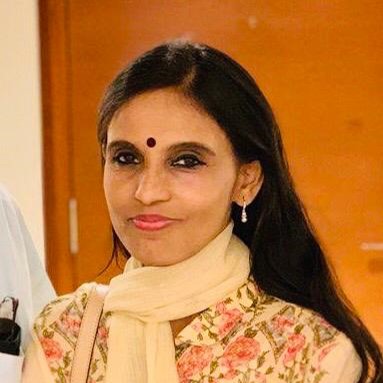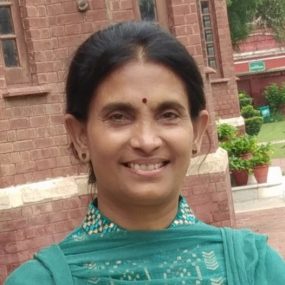Invited Speakers
(in alphabetical order)

Prof. Dr. Dayal Pyari Srivastava
Associate Professor, Dayalbagh Educational Institute, India
Dr. Dayal Pyari Srivastava is Assistant Professor at the Department of Physics and Computer Science, DEI. She obtained her Bachelor’s degree in Physics and Master’s degree in Electronics from Dayalbagh Educational Institute in 1985 and 1988 respectively. Subsequently, she obtained her Ph.D. on the topic “Graph Theoretic Quantum Field / System Modelling for Quantum Information / Computation Circuits and Algorithms” as a joint research scholar between DEI and IIT Delhi. She has been actively involved in physics education for over 20 years and has vast experience of science education.
She has published several papers in refereed international journals and co-authored a book entitled “Quantum Information Systems” published by McGraw Hill Education, particularly the R.K. Varshney Award of Systems Society of India for exceptional contributions to systems science, application, and technology. Her research interests include graph theoretic modelling modelling of quantum systems and consciousness studies.
Topic: Innovative Application Of Game Theory And Exploratory Measurement Of Spiritual Intelligence: A Brief Overview Of Research Work Of Students Supervised By Dr. Dayal Pyari Srivastava
TBA

Prof. Dr. Bani Dayal Dhir
Assistant Professor, Dayalbagh Educational Institute, India
Dr. Bani Dayal Dhir is Assistant Professor at the Department of English Studies, Dayalbagh Educational Institute (Deemed University)Agra, India. Recipient of the prestigious Director’s medal in BA Hons.(English), MA (English) and M.Phil.(English )programmes, her primary research interests include Literature , Theory and Consciousness studies. Her research endeavours are highly interdisciplinary in nature. Some of her notable contributions include “Graph Theoretic Field Modelling for Multi- Dimensional Literary Systems” (M.Phil. dissertation), “A Study of Emergentism and High End Complexity in Complex Literary Systems” (Ph.D. thesis). In recognition of her contribution to research in Systems Theory and literature, the Systems Society of India (SSI) honoured her with the National Young Systems Scientist award in 2009 and conferred its prestigious Raj Kumar Varshney award in 2017. She has travelled widely and has presented papers at various international and national conferences and won several best paper awards. As the Joint coordinator of Centre for Consciousness Studies, DEI from 2011- 17, she organized ‘East –West Forum’ for integrating the Eastern and the Western perspectives of consciousness at the annual international conference “The Science of Consciousness” organized by the Centre for Consciousness Studies, University of Arizona, USA. She has to her credit several research publications and creative non-fiction and poems in national and international journals. As the coordinator of (iNFORMATIONcOMMUNICATION- nEUROcOGNITIVE-) Technologies Assisted Language Lab, (i-c-n-c-) TALL, DEI, she has developed a state of the art multilingual digital language laboratory cum research centre.
TBA

Mrs. Prem Pyari Dayal
Prem Vidyalaya Girls' Intermediate College, Agra India
Mrs. Prem Pyari Dayal received the B.A. degree from University of Delhi in 1980, the M.A degree in Psychology and the B.Ed. degree from the Dayalbagh Educational Institute, Agra, in 1982 and 1984, respectively. Since 2009, she has been an honorary Lecturer in DEI Prem Vidyalaya Girls Intermediate College, Dayalbagh, Agra, India. Her research interest is in the science of consciousness.
“Karmas and the Necessity of the Sant Satguru of the Time to Attain Salvation”
Abstract
The gracious object of creation, according to Eastern wisdom, is to provide opportunity to conscious entities (spirit-forces) embodied in the covers of mind and matter (the human form), to eradicate their karmas (actions) and get purified according to the Penal Law of Creation, and thereby get emancipated to return to the original state of pure consciousness, i.e., its reservoir, the Supreme Being.
All human beings take birth on account of three kinds of actions or karmas, namely, Kriyaman, Prarabdh and Sanchit. Kriyaman are acts performed by a person in the present life, and the consequences of a greater part of these are borne in the present life. Prarabdh are acts performed in the past or present life, the consequences of which are to be reaped in the present life. Sanchit or unripe acts are performed in the past and present lives, the result of which is experienced in future lives.
Mind is extremely subtle matter and the two impressions, (i) those produced by external objects when they come into contact with the senses, and (ii) those produced by desires and various thoughts and ideas springing up from time to time in the mind, whether strong or feeble are scrupulously preserved in Manakasa (mind-sky). The impressions are reproduced by the association of complete attention with the impressions an entity has received, making it act entirely in accordance with the nature of those impressions, even when they are extremely feeble and even when they are not intelligible. These acts react upon the Manakasa, and by complete association of attention with them, can again constitute centers of future action.
Embodied consciousness in the human form, which is a spirit, mind and matter complex, keeps accumulating and getting entangled in innumerable karmas, which keep it confined to the cycle of birth and death. Karmas can only be eradicated and salvation achieved, by the grace, mercy and guidance of the Satguru (adept), who is in communion with the Supreme Being and Shabda, the primordial spiritual sound current. Selfless actions conforming to the instructions of the Satguru that are according to the will of the Supreme Being, ensure progress to higher spiritual planes during meditation and eradication of karmas. Adi Karma, the primeval downward tendency to associate with mind and matter is the root cause, which is destroyed through the meditational practice in Radhasoami Faith, which involves Sumiran (internal repetition of the divine name) and Dhyana (contemplation) of the Satguru, who projects His spirituality and love of the Supreme Being, pulling up with a stronger contrary force that overcomes the resistance of Adi Karma, thereby enabling the embodied consciousness to attain salvation.
In this paper, an attempt has been made to integrate Eastern and Western perspectives, to provide a scientific perspective on the dynamics of karmas. Embodied consciousness can be envisaged to be in entanglement with innumerable thoughts, desires, objects and other conscious entities.
Good or bad karmas are inherently based on contextuality of judgements and decisions. The context generated by making the first judgement or decision interferes with subsequent ones and create future potential. They give rise to propensities, dispositions and qualia that arise out of the decision-making history of each unit of consciousness in the universe, which generates its own karmas and affects others.
For eradication of karmas and to attain salvation the first necessary condition is to be in entanglement with the Satguru, the pure consciousness, subtler than the mental states and of much higher dimension, whose true form is Shabda, the spiritual sound current. This can be achieved by generating love for the Satguru and following the Bhakti Marg that is the Path of Devotion. The second necessary condition is to be non-judgmental, retain the indeterminate superposition state and to completely surrender to the Satguru, which is Saran, that is to be completely subservient to the interventions of the entangled Satguru, who can prompt changes in the appropriate entangled states, resulting in predictable changes in karmas and the state of an individual. The third condition is to practice ultra-transcendental meditation. Attention is an important cognitive function for conscious perception. Focusing attention on the Satguru during meditation by subverting all other entanglements, enables the Satguru to mitigate the effect of karmas, teleport the consciousness of an individual to higher states beyond those of the subtle mind, and help in attaining salvation.
To conclude, an attempt has been made to correlate the karma dynamics of consciousness, which happens at extremely subtle levels of the spirit and mind with entanglement that takes place at a subtle level in the physical plane.
A plausible scientific explanation has been proposed for justifying the Teachings of the Saints, the highest objective of which is (i) to search for the Satguru, (ii) to engender Love for Him, (iii) to completely surrender to His Will, and (iv) to practice Surat-Shabda-Yoga Meditation for eradicating karmas and attaining Salvation.